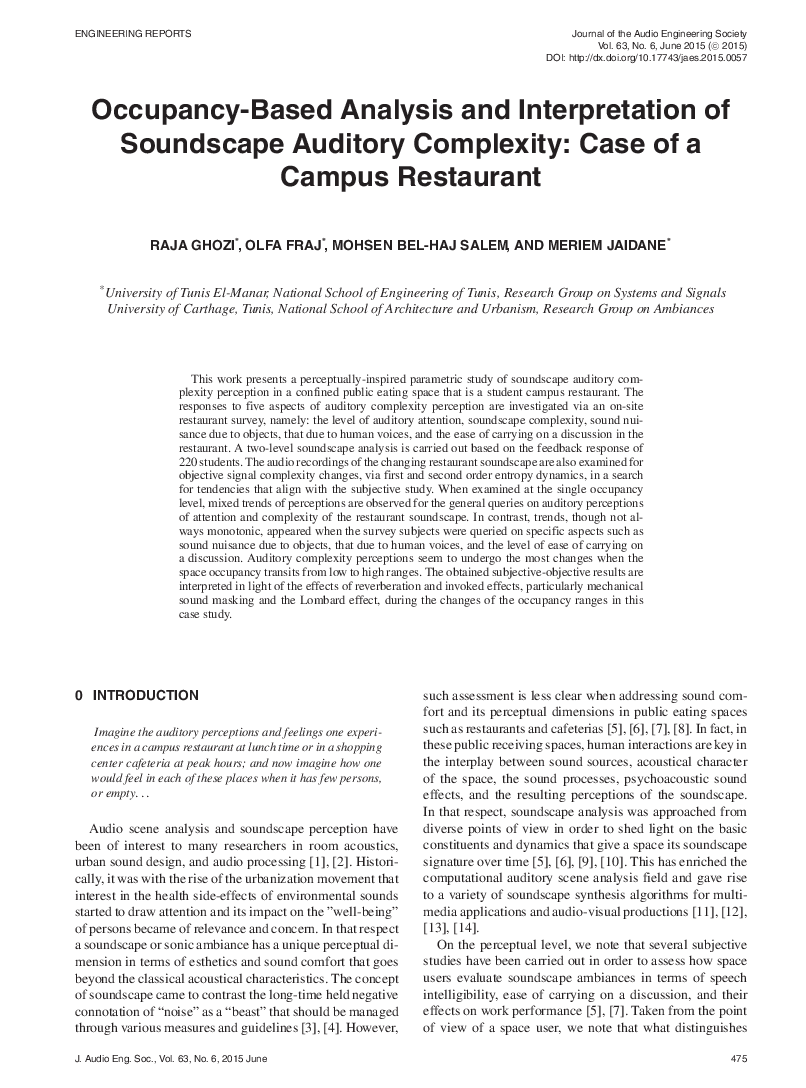Home / Publications / E-library page
You are currently logged in as an
Institutional Subscriber.
If you would like to logout,
please click on the button below.
Home / Publications / E-library page
Only AES members and Institutional Journal Subscribers can download
Audio scene analysis and soundscape perception have been of interest to many researchers in room acoustics, urban sound design, and audio processing. This article presents an analysis and interpretation of soundscape perceptions of a public confined eating space. Based on a realistic setting of a campus restaurant, a 220-subject survey was conducted where various auditory complexity perceptions were queried as the space went from empty to full occupancy. The responses to five aspects of auditory complexity perception are investigated via an on-site survey: the level of auditory attention, soundscape complexity, sound nuisance due to objects, that due to human voices, and the ease of carrying on a discussion in the restaurant. The audio recordings of the changing restaurant soundscape were examined for objective signal complexity changes, via first- and second-order entropy dynamics, in a search for tendencies that align with the subjective study. Nonmonotic changes of these perceptions were noted with increasing occupancy levels. Various physical, spatial, and human factors, which are in constant interaction to form a composite experience and therefore a complex soundscape, all of which play a contributing role.
Author (s): Ghozi, Raja; Fraj, Olfa; Salem, Mohsen Bel-haj; Jaidane, Meriem
Affiliation:
University of Tunis El-Manar, National School of Engineering of Tunis, Research Group on Systems and Signals; University of Carthage, Tunis, National School of Architecture and Urbanism, Research Group on Ambiances
(See document for exact affiliation information.)
Publication Date:
2015-06-06
Import into BibTeX
Permalink: https://aes2.org/publications/elibrary-page/?id=17826
(4000KB)
Click to purchase paper as a non-member or login as an AES member. If your company or school subscribes to the E-Library then switch to the institutional version. If you are not an AES member Join the AES. If you need to check your member status, login to the Member Portal.

Ghozi, Raja; Fraj, Olfa; Salem, Mohsen Bel-haj; Jaidane, Meriem; 2015; Occupancy-Based Analysis and Interpretation of Soundscape Auditory Complexity: Case of a Campus Restaurant [PDF]; University of Tunis El-Manar, National School of Engineering of Tunis, Research Group on Systems and Signals; University of Carthage, Tunis, National School of Architecture and Urbanism, Research Group on Ambiances; Paper ; Available from: https://aes2.org/publications/elibrary-page/?id=17826
Ghozi, Raja; Fraj, Olfa; Salem, Mohsen Bel-haj; Jaidane, Meriem; Occupancy-Based Analysis and Interpretation of Soundscape Auditory Complexity: Case of a Campus Restaurant [PDF]; University of Tunis El-Manar, National School of Engineering of Tunis, Research Group on Systems and Signals; University of Carthage, Tunis, National School of Architecture and Urbanism, Research Group on Ambiances; Paper ; 2015 Available: https://aes2.org/publications/elibrary-page/?id=17826
@article{ghozi2015occupancy-based,
author={ghozi raja and fraj olfa and salem mohsen bel-haj and jaidane meriem},
journal={journal of the audio engineering society},
title={occupancy-based analysis and interpretation of soundscape auditory complexity: case of a campus restaurant},
year={2015},
volume={63},
issue={6},
pages={475-487},
month={june},}
TY – paper
TI – Occupancy-Based Analysis and Interpretation of Soundscape Auditory Complexity: Case of a Campus Restaurant
SP – 475 EP – 487
AU – Ghozi, Raja
AU – Fraj, Olfa
AU – Salem, Mohsen Bel-haj
AU – Jaidane, Meriem
PY – 2015
JO – Journal of the Audio Engineering Society
VO – 63
IS – 6
Y1 – June 2015